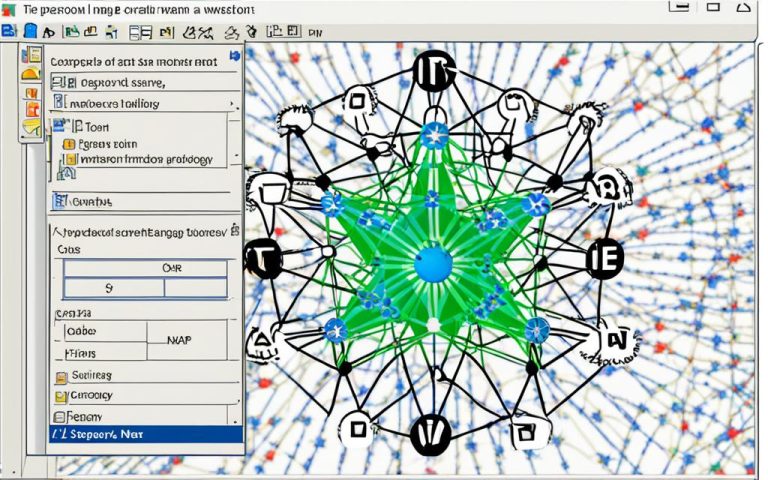Personal Area Networks (PANs) have become an essential part of the Internet of Things (IoT) ecosystem. PANs are autonomous systems that connect various devices and enable seamless communication and data exchange. They rely on a variety of protocols to facilitate data transmission, actuation, sensing, and decision-making. PANs are powered by wireless technologies such as Wi-Fi, Zigbee, and Bluetooth, which enable devices to connect and interact with each other. These protocols play a crucial role in ensuring seamless connectivity and efficient communication within PANs, making them essential for the functioning of IoT technology.
PAN Protocols, Personal Area Networks, IoT technology, wireless technologies, data transmission, actuation, sensing, decision-making
The Importance of IoT in Economic Development
The Internet of Things (IoT) has emerged as a key driver of economic development. It transforms various domains of life into autonomous systems that communicate with the physical world through data transmission, analytics, and decision-making. IoT technology is applicable in almost every aspect of life, from homes and workplaces to industrial and healthcare facilities.
“IoT is revolutionizing industries, enabling greater efficiency, productivity, and innovation. It has the potential to unlock trillions of dollars in economic value globally.”
– John Chambers, Former CEO of Cisco Systems
The growth of smart systems, enabled by wireless technologies, has led to the generation of massive volumes of data. IoT protocols play a crucial role in processing, storing, and displaying this data effectively, making them essential for the seamless functioning of IoT-based systems.
In today’s interconnected world, IoT offers numerous benefits for economic development:
- Enhanced Efficiency: IoT technologies enable automation and optimization of various processes, leading to increased productivity and reduced costs.
- Improved Decision-Making: Data collected from IoT devices can be analyzed to gain valuable insights, enabling informed decision-making and strategic planning.
- Increased Safety and Security: IoT devices can monitor and detect potential risks, allowing for proactive measures to ensure safety and security in various environments.
- Facilitated Customer Experiences: IoT applications allow for personalized and interactive customer experiences, enhancing customer satisfaction and loyalty.
The Economic Impact of IoT
The economic impact of IoT is vast and far-reaching. According to a report by McKinsey & Company, IoT has the potential to create an economic impact of $3.9 trillion to $11.1 trillion per year by 2025. This impact can be seen across various sectors, including:
| Sector | Economic Impact |
|---|---|
| Manufacturing | $1.2 trillion to $3.7 trillion |
| Healthcare | $760 billion to $2.5 trillion |
| Retail | $410 billion to $1.2 trillion |
| Transportation | $200 billion to $890 billion |
| Smart Cities | $930 billion to $1.7 trillion |
The economic development driven by IoT presents immense opportunities for businesses and economies globally. Embracing IoT technologies and harnessing their potential can lead to increased competitiveness, innovation, and sustainable growth.
The Motivations for Developing PAN Protocols
The expansion of IoT applications and operations has led to the development of various PAN protocols. These protocols are designed to satisfy the specific needs of different use cases within the IoT ecosystem. However, choosing the right communication protocol for a new design can be challenging, as there are numerous protocols to choose from, and many of them are complex or inaccessible.
Making the wrong protocol choice can result in delays in production and increased design expenditure.
Therefore, the motivations behind developing PAN protocols are to provide designers and developers with a range of options and to ensure efficient communication throughout the IoT ecosystem.
| Benefits of PAN Protocols | Challenges in Protocol Choice |
|---|---|
| 1. Seamless connectivity and data exchange among IoT devices | 1. Complexity and inaccessibility of some protocols |
| 2. Optimization for specific use cases | 2. Ensuring compatibility with existing infrastructure |
| 3. Enhanced security and reliability | 3. Scalability and future-proofing |
By offering a wide range of PAN protocols, designers and developers can select the most suitable one for their specific design requirements. This promotes flexibility and adaptability in IoT applications, ensuring seamless integration and efficient communication between devices.
The State-of-the-Art PAN Protocols
Numerous studies and articles have explored the different aspects of IoT, including its architectures, techniques, and various protocols. These studies provide comparative methodologies and analyze the performance and capabilities of different PAN protocols. They examine IoT architectures, communication technologies, security mechanisms, and protocol standards. The aim is to provide a comprehensive overview of the state-of-the-art PAN protocols and their features, strengths, and weaknesses. These studies are valuable resources for researchers and professionals interested in understanding and implementing PAN protocols in their IoT applications.
Comparative methodologies are utilized to evaluate the performance and efficiency of different PAN protocols. Through these methodologies, researchers can analyze the strengths and weaknesses of each protocol to determine their suitability for specific IoT architectures. These evaluations consider factors such as communication technologies, security mechanisms, and protocol standards to assess the overall effectiveness of PAN protocols.
Understanding the state-of-the-art PAN protocols is crucial for professionals involved in IoT development and implementation. By staying informed about the latest advancements, researchers can make informed decisions regarding the selection and integration of PAN protocols into IoT architectures. This ensures the development of robust and efficient IoT systems that take advantage of the most suitable communication technologies and security mechanisms.
To provide an overview of the research conducted in the field, here are some examples of the state-of-the-art PAN protocols:
Example 1: Protocol A
Protocol A is a PAN protocol that focuses on low-power communication and seamless integration with existing IoT architectures. It utilizes advanced encryption techniques to ensure secure data transmission and incorporates efficient routing algorithms to optimize network performance. Protocol A has been widely adopted in various IoT applications, particularly those requiring real-time data processing and high reliability.
Example 2: Protocol B
Protocol B is specifically designed for IoT architectures that prioritize scalability and interoperability. It supports a wide range of communication technologies, including Wi-Fi, Bluetooth, and Zigbee, enabling seamless integration with different IoT devices. Protocol B also implements robust security mechanisms, such as authentication and access control, to protect sensitive data and ensure the privacy of IoT systems.
These examples highlight the diverse range of state-of-the-art PAN protocols available. Each protocol offers unique features and capabilities to address specific requirements within IoT architectures. By understanding the strengths and weaknesses of these protocols, researchers and professionals can make informed decisions regarding their implementation, ensuring optimal performance and security in IoT applications.

Overview of 6LoWPAN and IP Networks
6LoWPAN (IPv6-based Low-Power Personal Area Networks) is a network formed by devices compatible with the IEEE 802.15.4 standard. It enables efficient communication within low-power wireless networks by fragmenting and reassembling IPv6 packets.
IP networks, on the other hand, are computer networks that use the Internet Protocol (IP) to facilitate communication between interconnected devices. IP networks rely on IP addressing and packet routing to ensure data packets reach their intended destinations. These networks form the backbone of the internet and support various internet activities, including web browsing, email services, and video streaming.
6LoWPAN and IP networks are essential components of the IoT ecosystem that enable secure and efficient internet communication. By leveraging the power of IPv6 and IP addressing, 6LoWPAN ensures seamless connectivity while conserving power in low-power personal area networks. It facilitates the integration of IoT devices and enables effective communication within these networks.
6LoWPAN allows devices with limited resources to connect to IP networks, opening up a wide range of possibilities for IoT applications and enabling the deployment of wireless sensor networks in various domains.
Advantages of 6LoWPAN and IP Networks:
- Efficient communication within low-power wireless networks
- Integration with the internet and IP-based infrastructure
- Support for a wide range of IoT applications
- Scalability and flexibility in network design
- Seamless connectivity and data transmission
- Enhanced security through IP-based protocols
6LoWPAN and IP networks have revolutionized the IoT landscape by enabling seamless communication and connectivity between devices. The combination of IPv6, IP addressing, and packet routing ensures efficient data transfer, allowing IoT devices to interact and share information effectively.
Conclusion
In conclusion, PAN protocols are indispensable for the seamless functioning of Personal Area Networks within the IoT ecosystem. These protocols play a critical role in enabling efficient communication, data transmission, and decision-making within IoT-based systems. Designed to meet the specific requirements of diverse IoT applications and operations, PAN protocols ensure the smooth functioning of interconnected devices.
The rapid growth of the IoT ecosystem has fueled the development of PAN protocols to meet the increasing demand for reliable and efficient communication. By providing a range of protocols and options, PAN protocols address the unique needs of different IoT applications. This diversity in protocols empowers designers and developers to choose the most suitable communication protocols for their designs, thereby enhancing the overall performance and effectiveness of IoT systems.
Furthermore, IP networks and 6LoWPAN contribute to the enhanced capabilities of PAN protocols by facilitating seamless communication and data transfer. IP networks, being the backbone of the internet, enable reliable packet routing and IP addressing. 6LoWPAN, on the other hand, optimizes communication within low-power wireless networks by fragmenting and reassembling IPv6 packets. Together, these technologies support the efficient functioning of PAN protocols and reinforce the success and growth of IoT technology.
In conclusion, PAN protocols are crucial for establishing reliable communication, seamless data transmission, and efficient decision-making within Personal Area Networks in the IoT ecosystem. These protocols, in conjunction with IP networks and 6LoWPAN, form the foundation for IoT technology and enable the realization of its full potential. As the IoT ecosystem expands further, the development and adoption of innovative PAN protocols will continue to be vital to meet the evolving demands of this rapidly evolving technology landscape.
FAQ
What are PAN protocols?
PAN protocols are communication protocols that enable seamless communication, data transmission, and decision-making within Personal Area Networks (PANs) in the Internet of Things (IoT) ecosystem.
What is the role of PAN protocols in IoT technology?
PAN protocols play a critical role in powering PANs within the IoT ecosystem by ensuring efficient and reliable communication between devices, data transmission, and decision-making within IoT-based systems.
Why are PAN protocols important for the growth of IoT technology?
PAN protocols are essential for the success and growth of IoT technology as they provide a range of protocols and options for designers and developers, ensuring seamless connectivity and efficient communication throughout the IoT ecosystem.
How can PAN protocols benefit IoT applications and operations?
PAN protocols are designed to satisfy the specific needs of different IoT applications and operations, enabling efficient and reliable communication, data transmission, and decision-making within IoT-based systems.
Where can I find more information about PAN protocols?
Numerous studies and articles have explored different aspects of PAN protocols, including their features, strengths, and weaknesses. These studies provide a comprehensive overview of the state-of-the-art PAN protocols and are valuable resources for researchers and professionals interested in implementing PAN protocols in their IoT applications.
How does 6LoWPAN and IP networks enhance PAN protocols?
6LoWPAN is an IPv6-based Low-Power Personal Area Network that enables efficient communication within low-power wireless networks by fragmenting and reassembling IPv6 packets. IP networks, on the other hand, use the Internet Protocol (IP) to facilitate communication between interconnected devices, enhancing the capabilities of PAN protocols for efficient communication and data transfer.



















